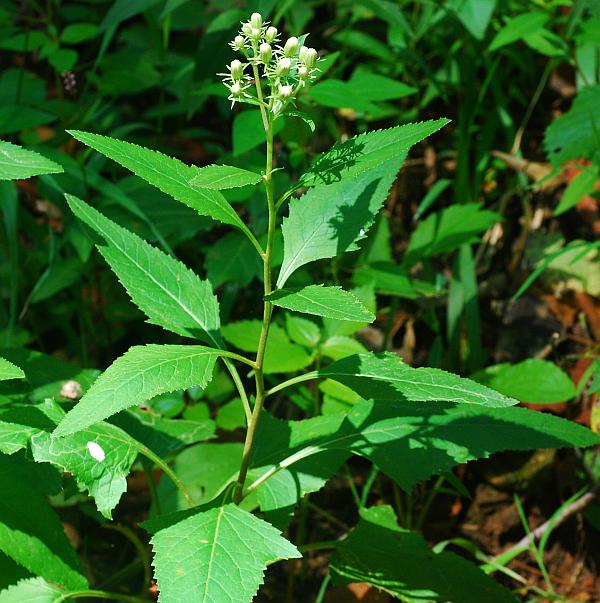Hasteola suaveolens (L.) Pojark.
False Indian Plantain

Native
CC = 9
CW = -3
MOC = 9
© SRTurner
Hasteola suaveolens (L.) Pojark.False Indian Plantain | |
 |
Native CC = 9 CW = -3 MOC = 9 |
© SRTurner |
|
Family - Asteraceae/Senecioneae Habit - Perennial forb, the rootstock with somewhat fleshy roots and slender, fleshy rhizomes. Stem - Erect, to 1.8 m, unbranched, usually unbranched below the inflorescence, usually finely lined or grooved, glabrous or nearly so.
Leaves - Basal and alternate, simple, petiolate, progressively reduced in size from the stem base to the tip, glabrous or nearly so. Basal and lowermost stem leaves long-petiolate, the blades simple, 15-35 cm long, sharply triangular to hastate, tapered to a sharply pointed tip, with a pair of spreading, triangular basal lobes, the base otherwise truncate to nearly cordate, tapering abruptly to the petiole, the margins sharply toothed, the venation palmate with 1 main vein and a pair of spreading main veins running into the lobes. Upper leaves with progressively shorter petioles, the uppermost leaves usually narrowly lanceolate and unlobed.
Inflorescence - Terminal and axillary panicles of heads, broadly rounded or flat-topped.
Heads - Discoid, short-to long-stalked, mostly with 20-45 florets. Involucre 10-14 mm long, narrowly bell-shaped, the bracts in 2 series, sometimes sparsely and minutely hairy near the base and/or tip, the inner series of 10-15 bracts, these relatively flat dorsally and typically whitened near apex, the outer series of 5-11 bracts, these 1/2 or more as long as the inner series, spreading, uniformly green.
Florets - Disk florets 20-45 per head, the corollas 8-12 mm long, white or cream colored. Style branches with a stigmatic line along each inner margin. Pappus of numerous capillary bristles. Ray florets absent.
Fruits - Achenes 5-8 mm long, more or less linear in outline, not flattened, 8-12-ribbed, glabrous, light brown to pale green. Flowering - July - September. Habitat - Bottomland forests, bases of sheltered bluffs, sloughs, streambanks. Origin - Native to the U.S. Lookalikes - None close. Other info. - This interesting species is uncommon in Missouri, reported from only in a few counties mostly clustered in the east-central part of the state. Beyond Missouri its range extends across parts of the northeastern U.S., though it is uncommon in most places. The plant is perhaps most striking when in bud, with the spreading outer involucral bracts and nearly white inner bract tips giving rise to a characteristic "starry" appearance. The hastate lower leaves are also distinctive. Photographs taken along Tuque Creek, Warren County, MO, 8-19-2010, Little Lost Creek Conservation Area, Warren County, MO, 7-12-2012, 9-6-2015, and 9-6-2016, and along the Chubb Trail, St. Louis County, MO, 8-29-2017 (SRTurner). |